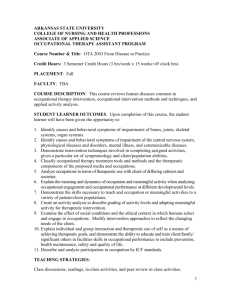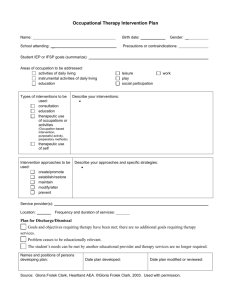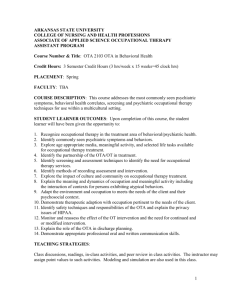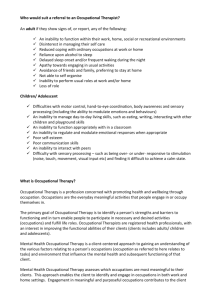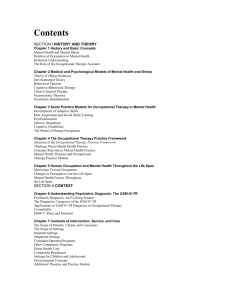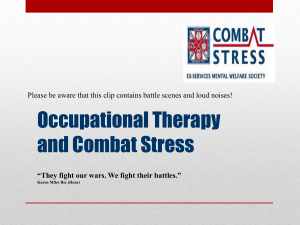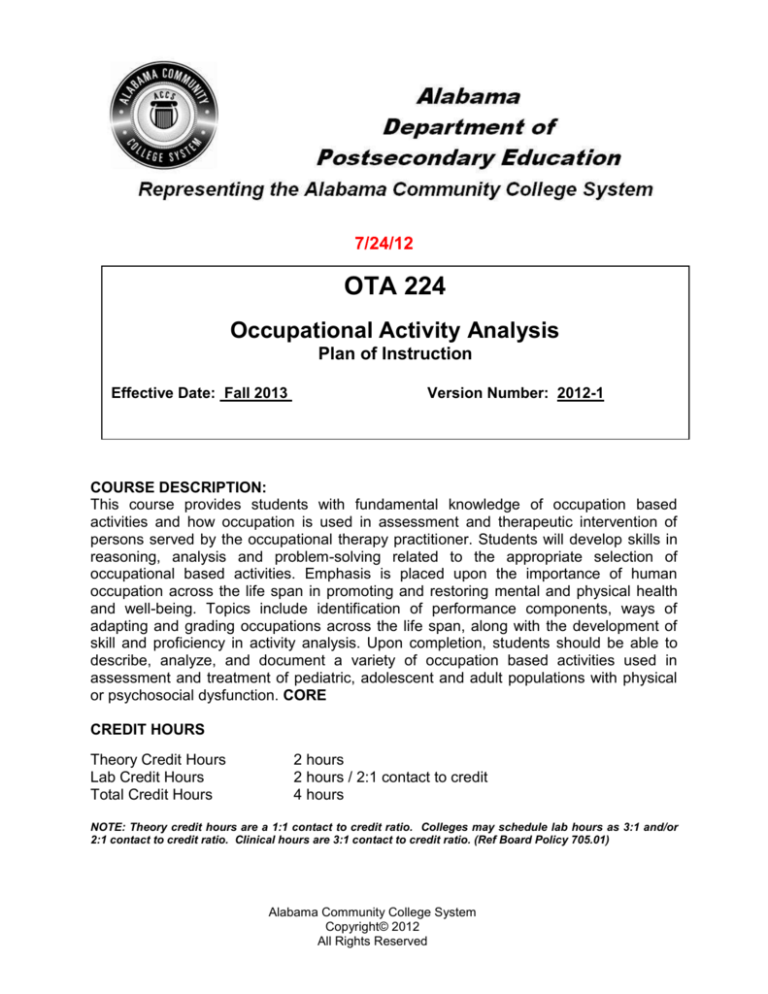
7/24/12
OTA 224
Occupational Activity Analysis
Plan of Instruction
Effective Date: Fall 2013
Version Number: 2012-1
COURSE DESCRIPTION:
This course provides students with fundamental knowledge of occupation based
activities and how occupation is used in assessment and therapeutic intervention of
persons served by the occupational therapy practitioner. Students will develop skills in
reasoning, analysis and problem-solving related to the appropriate selection of
occupational based activities. Emphasis is placed upon the importance of human
occupation across the life span in promoting and restoring mental and physical health
and well-being. Topics include identification of performance components, ways of
adapting and grading occupations across the life span, along with the development of
skill and proficiency in activity analysis. Upon completion, students should be able to
describe, analyze, and document a variety of occupation based activities used in
assessment and treatment of pediatric, adolescent and adult populations with physical
or psychosocial dysfunction. CORE
CREDIT HOURS
Theory Credit Hours
Lab Credit Hours
Total Credit Hours
2 hours
2 hours / 2:1 contact to credit
4 hours
NOTE: Theory credit hours are a 1:1 contact to credit ratio. Colleges may schedule lab hours as 3:1 and/or
2:1 contact to credit ratio. Clinical hours are 3:1 contact to credit ratio. (Ref Board Policy 705.01)
Alabama Community College System
Copyright© 2012
All Rights Reserved
Occupational Activity Analysis
OTA 224
PREREQUISITE COURSES
As determined by college.
CO-REQUISITE COURSES:
As determined by college.
INSTRUCTOR NOTE:
This new course is a combination of what was OTA 210 & 211. The original OTA 224
was renamed and moved to OTA 231.
PROFESSIONAL COMPETENCIES
Describe the meaning and dynamics of occupation and activity and its
importance to the balance of areas of occupation to achieve health and wellness.
Explain activity analysis and how it is utilized by OT practitioners.
Demonstrate skill in assisting a patient through an activity using teaching and
learning principles.
Select and determine if activity is a specified person- activity- environment fit by
performing an activity analysis.
Demonstrate compensatory techniques for individuals with specific functional
impairments to increase independence in occupational roles.
Demonstrate how to grade activities and occupations to reach desired outcomes.
Demonstrate how to adapt activities and occupations to reach desired outcomes.
Identify and select appropriate activities for use in occupational therapy practice.
Teach a group activity.
INSTRUCTIONAL GOALS
Cognitive – Comprehend principles and concepts related to occupational activity
analysis.
Psychomotor – Apply principles of occupational activity analysis.
Affective – Value the importance of adhering to policy and procedures related to
occupational activity analysis.
STUDENT OBJECTIVES
Condition Statement: Unless otherwise indicated, evaluation of student’s attainment
of objectives is based on knowledge gained from this course. Specifications may be in
the form of, but not limited to, cognitive skills diagnostic instruments, manufacturer’s
specifications, technical orders, regulations, national and state codes, certification
agencies, locally developed lab/clinical assignments, or any combination of
specifications.
ACCS Copyright© 2012
All Rights Reserved
2
Occupational Activity Analysis
OTA 224
STUDENT LEARNING OUTCOMES
MODULE A – INTRODUCTION TO OCCUPATIONAL ACTIVITY ANALYSIS
MODULE DESCRIPTION – The purpose of this module is to teach the students the
meaning and dynamics of occupation and activity and its importance to the balance of
areas of occupation to achieve health and wellness. Also included is an explanation of
activity analysis and how it is utilized by OT practitioners. Topics include activity analysis,
grading activities, adapting activities, and documentation.
PROFESSIONAL COMPETENCIES
PERFORMANCE OBJECTIVES
KSA
A1.0 Describe the meaning and
A1.1 This competency is measured
1
dynamics of occupation and
cognitively.
activity and its importance to
the balance of areas of
occupation to achieve health
and wellness.
A2.0 Explain activity analysis and
how it is utilized by OT
practitioners.
A.2.1 This competency is measured
cognitively.
LEARNING OBJECTIVES
1
KSA
A1.1.1 Define purposeful activity as it relates to occupation and meaning to the
client.
A1.1.2 Compare and contrast purposeful activity to enabling and adjunctive
treatment activities.
A1.1.3 Identify performance skills required within selected purposeful activities.
1
A2.1.1 Describe components of activity analysis, and why occupational therapy
assistants require this skill.
MODULE A OUTLINE:
Historical roots of crafts and other occupations
Benefits of occupations as therapeutic tools
How crafts and occupations promote brain function
Justification of use of crafts in rehabilitation
How to use crafts and other occupations
o Activity analysis
o Grading activities
o Adapting activities
o Documentation
1
ACCS Copyright© 2012
All Rights Reserved
3
1
1
Occupational Activity Analysis
OTA 224
MODULE B – THE TEACHING-LEARNING PROCESS
MODULE DESCRIPTION – The purpose of this module is to teach the student to assist a
patient through an activity using teaching and learning principles. Topics include
communication, professional relationships, learning styles, cultural influences, pacing, trial
and error, setting goals, practice, and problem solving.
PROFESSIONAL COMPETENCIES
PERFORMANCE OBJECTIVES
KSA
B1.0 Demonstrate skill in assisting a B1.1 This competency is measured by
3
patient through an activity
teaching a peer how to produce a
using teaching and learning
product.
principles.
LEARNING OBJECTIVES
B1.1.1 Produce samples of activities used as therapeutic media reflective of OT
practice.
B1.1.2 Identify levels of assistance required for a patient to successfully
complete an activity.
MODULE B OUTLINE:
Teaching-Learning Introduction
o Communication
o Professional relationship
o Learning styles
o Cultural influences
o Pacing
o Trial and error
o Setting goals
o Practice
o Problem solving
KSA
2
3
MODULE C– ANALYZING THERAPEUTIC OCCUPATIONS
MODULE DESCRIPTION – The purpose of this module is to teach the student to select
and determine if activity is a specified person- activity- environment fit by performing an
activity analysis. Topics include occupation-based activity analysis, and what is being
analyzed.
PROFESSIONAL COMPETENCIES
PERFORMANCE OBJECTIVES
KSA
C1.0 Select and determine if activity C1.1 This competency is measured
3
is a specified person- activitycognitively.
environment fit by performing
an activity analysis.
LEARNING OBJECTIVES
KSA
C1.1.1 Analyze therapeutic activities to determine if an activity will meet patient
needs and treatment goals relative to areas of occupation, performance
3
ACCS Copyright© 2012
All Rights Reserved
4
Occupational Activity Analysis
OTA 224
skills, performance patterns and activity demands & context.
C1.1.2 Produce samples of activities used as therapeutic media reflective of OT
practice.
C1.1.3 Determine if activity is a specified person-activity-environment fit, and
how to adapt and/or grade the activity as necessary.
3
3
MODULE C OUTLINE:
Occupation-Based Activity analysis
What are we analyzing?
o Sequence and timing
o Objects, space, social demands
o Required body functions
o Required body structures
o Required actions/performance skills
MODULE D – COMPENSATORY TECHNIQUES
MODULE DESCRIPTION – The purpose of this module is to teach the student the
compensatory techniques for individuals with specific functional impairments to increase
independence in occupational roles. Topics include addressing short and long term goals,
and alternate methods or performing activities.
PROFESSIONAL COMPETENCIES
PERFORMANCE OBJECTIVES
KSA
D1.0 Demonstrate compensatory
D1.1 Demonstrate appropriate
3
techniques for individuals with
compensatory techniques.
specific functional impairments
to increase independence in
occupational roles.
LEARNING OBJECTIVES
KSA
D1.1.1 Identify compensatory techniques necessary to perform life tasks.
D1.1.2 Describe the adaptive techniques used for various life tasks.
D1.1.3 Identify the adaptive equipment indicated for successful task completion.
D1.1.4 Utilize the adaptive equipment indicated for successful task completion.
MODULE D OUTLINE:
Addressing short-term and long-term goals
o Identify desired outcomes
o Applying OT to life situations
Alternate methods or performing activities
o Compensatory techniques
o Using assistive devices
o Determining levels of assistance
o Grading activities
2
3
1
3
ACCS Copyright© 2012
All Rights Reserved
5
Occupational Activity Analysis
OTA 224
MODULE E – GRADING ACTIVITIES OR OCCUPATIONS
MODULE DESCRIPTION – The purpose of this module is to teach the student to grade
activities and occupations to reach desired outcomes. Topics include components of
grading, scaffolding, and grading activities.
PROFESSIONAL COMPETENCIES
PERFORMANCE OBJECTIVES
KSA
E1.0 Demonstrate how to grade
E1.1 Demonstrate grading activities.
3
activities and occupations to
reach desired outcomes.
LEARNING OBJECTIVES
E1.1.1 Grade and adapt purposeful therapeutic activities to allow patients to
meet treatment goals.
E1.1.2 Produce samples of activities used as therapeutic media reflective of OT
Practice.
E1.1.3 Determine if activity is a specified person-activity-environment fit, and
how to adapt and/or grade the activity as necessary.
KSA
3
2
3
MODULE E OUTLINE:
Grading in OT Practice
o Components
o Scaffolding
o Grading activities – simple to complex
MODULE F – ADAPTING ACTIVITIES OR OCCUPATIONS
MODULE DESCRIPTION – The purpose of this module is to teach the student to adapt
activities and occupations to reach desired outcomes. Topics include adaptations to meet
patient needs, and adapting the activity.
PROFESSIONAL COMPETENCIES
PERFORMANCE OBJECTIVES
KSA
F1.0 Demonstrate how to adapt
F1.1 Create adaptive equipment or
3
activities and occupations to
adapt an activity for patient
reach desired outcomes.
success.
LEARNING OBJECTIVES
F1.1.1 Grade and adapt purposeful therapeutic activities to allow patients to
meet treatment goals.
F1.1.2 Produce samples of activities used as therapeutic media reflective of OT
practice.
F1.1.3 Determine if activity is a specified person-activity-environment fit, and
how to adapt and/or grade the activity as necessary.
F1.1.4 Construct an assistive device or adaptive equipment to be used for
compensation for physical, cognitive or neuromuscular skills.
KSA
3
2
3
3
MODULE F OUTLINE:
ACCS Copyright© 2012
All Rights Reserved
6
Occupational Activity Analysis
OTA 224
Adaptations to meet patient needs
o Environmental
o Positional
o Instructional
o Compensatory
o Equipment
Adapting the Activity
o Problem solving
o Determining fit
o Patient compliance
MODULE G – SELECTION OF TREATMENT ACTIVITIES
MODULE DESCRIPTION – The purpose of this module is to teach the student to identify
and select appropriate activities for use in occupational therapy practice. Topics include
selecting appropriate activities, selection of activities to improve function, and engaging
patients in treatment.
PROFESSIONAL COMPETENCIES
PERFORMANCE OBJECTIVES
KSA
G1.0 Identify and select appropriate
G1.1 This competency is measured
3
activities for use in
cognitively.
occupational therapy practice.
LEARNING OBJECTIVES
KSA
G1.1.1 Identify performance skills required within selected purposeful activities.
G1.1.2 Analyze therapeutic activities to determine if an activity will meet patient
needs and treatment goals relative to areas of occupation, performance
skills, performance patterns and activity demands & context.
G.1.1.3 Select appropriate treatment activities that will meet treatment goals
based on patient strengths and needs.
MODULE G OUTLINE:
Selecting appropriate activities
o Gradable
o Adaptable
o Requires repetitive action
o Meets patient interest
o Meets goals
o Appropriate level of challenge
Selection of activities to improve function
o Range of motion
o Strength
o Coordination
o Mental factors
Engaging patients in treatment
o Motivation
o Compliance
2
3
ACCS Copyright© 2012
All Rights Reserved
7
3
Occupational Activity Analysis
OTA 224
MODULE H – TEACHING ACTIVITIES
MODULE DESCRIPTION – The purpose of this module is to teach the student how to
teach a group activity.
PROFESSIONAL COMPETENCIES
PERFORMANCE OBJECTIVES
KSA
H1.0 Teach a group activity.
H1.1 Plan and implement a small group
3
activity.
LEARNING OBJECTIVES
KSA
H1.1.1 Produce samples of activities used as therapeutic media reflective of OT
practice.
H1.1.2 Identify teaching/learning concepts and communication skills required
when conducting small groups.
2
ACCS Copyright© 2012
All Rights Reserved
8
3
Occupational Activity Analysis
OTA 224
LEARNING OUTCOMES TABLE OF SPECIFICATIONS
The table below identifies the percentage of learning objectives for each module.
Instructors should develop sufficient numbers of test items at the appropriate
level of evaluation.
Limited
Knowledge and
Proficiency
KSA
Module A
Module B
Module C
Module D
Module E
Module F
Module G
Module H
1
100%
25%
Moderate
Knowledge
and
Proficiency
2
Advanced
Knowledge
and
Proficiency
3
50%
50%
100%
50%
67%
75%
67%
50%
25%
33%
25%
33%
50%
Superior
Knowledge
and
Proficiency
4
The KSA is NOT determined by the verb used in the learning objective, but rather in the context in which
the verb is used and the depth of knowledge and skills required.
Example: Three KSA levels using the same verb (describe):
KSA 1 – Describe three characteristics of metamorphic rocks. (simple recall)
KSA 2 – Describe the difference between metamorphic and igneous rocks. (requires cognitive
processing to determine the differences in the two rock types)
KSA 3 – Describe a model that you might use to represent the relationships that exist within the rock
cycle. (requires deep understanding of rock cycle and a determination of how best to represent it)
ACCS Copyright© 2012
All Rights Reserved
9
Occupational Activity Analysis
Indicator Key Terms
1
Limited
Knowledge
and
Proficiency
2
Moderate
Knowledge
and
Proficiency
3
Advanced
Knowledge
and
Proficiency
4
Superior
Knowledge
and
Proficiency
A
Affective
Objective
ACCS Copyright© 2012
All Rights Reserved
OTA 224
Learner’s Knowledge, Skills and Abilities
Description
Recognize basic information about the subject including terms
and nomenclature.
Students must demonstrate ability to recall information such as
facts, terminology or rules related to information previously
taught.
Performs simple parts of the competency. Student requires
close supervision when performing the competency.
Distinguish relationships between general principles and facts.
Adopts prescribed methodologies and concepts.
Students must demonstrate understanding of multiple facts
and principles and their relationships, and differentiate between
elements of information. Students state ideal sequence for
performing task.
Performs most parts of the competency with instructor
assistance as appropriate.
Examines conditions, findings, or other relevant data to select an
appropriate response.
The ability to determine why and when a particular response is
appropriate and predict anticipated outcomes.
Students demonstrate their ability to seek additional information
and incorporate new findings into the conclusion and justify their
answers.
Performs all parts of the competency without instructor
assistance.
Assessing conditions, findings, data, and relevant theory to
formulate appropriate responses and develop procedures for
situation resolution. Involves higher levels of cognitive
reasoning.
Requires students to formulate connections between relevant
ideas and observations.
Students apply judgments to the value of alternatives and select
the most appropriate response.
Can instruct others how to do the competency.
Performs competency quickly and accurately.
Describes learning objectives that emphasize a feeling tone, an
emotion, or a degree of acceptance or rejection.
Objectives vary from simple attention to selected phenomena to
complex but internally consistent qualities of character and
conscience.
Expressed as interests, attitudes, appreciations, values, and
emotional sets or biases.
10

